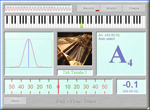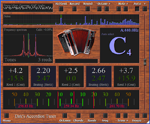
Information
The equal temperament
The tuning or temperament of a scale is the way the frequencies of the notes are chosen. In Western music the equal temperament is most popular. Other temperaments are for example: the just intonation, the Pythagorean tuning, the mean tone temperament, the well temperament and the 31 equal temperament.
An octave is divided into 12 'proportionally increasing' distances. The ratio of the frequencies of two successive semitones is always the same (approximately 1.0594631). Because of this, all intervals (second, third, fourth, fifth, sixth, seventh), except the octave, deviate from the just tuning. They cause beating. All equally named intervals sound equally false (they beat). The advantage of this tuning is that it remains the same when switched to another tone type (a number of semitones higher or lower), and it is therefore not needed to tune the instrument differently.
Below an overview is given of the intervals and the differences of the equal and the just temperament. The just temperament is the way to construct a scale where the frequency ratios are simple integers. This produces music which is experienced as pure (not false).
An octave is divided into 12 'proportionally increasing' distances. The ratio of the frequencies of two successive semitones is always the same (approximately 1.0594631). Because of this, all intervals (second, third, fourth, fifth, sixth, seventh), except the octave, deviate from the just tuning. They cause beating. All equally named intervals sound equally false (they beat). The advantage of this tuning is that it remains the same when switched to another tone type (a number of semitones higher or lower), and it is therefore not needed to tune the instrument differently.
Below an overview is given of the intervals and the differences of the equal and the just temperament. The just temperament is the way to construct a scale where the frequency ratios are simple integers. This produces music which is experienced as pure (not false).
| Interval | Equal | Just | ∆ | |
| Unison | 1.000 | 1.000 | 1/1 | 0.0% |
| Minor second | 1.059 | 1.067 | 16/15 | -0.7% |
| Major second | 1.122 | 1.125 | 9/8 | -0.2% |
| Minor third | 1.189 | 1.200 | 6/5 | -0.9% |
| Major third | 1.260 | 1.250 | 5/4 | +0.8% |
| Fourth | 1.335 | 1.333 | 4/3 | +0.1% |
| Augmented fourth | 1.414 | 1.400 | 7/5 | +1.0% |
| Fifth | 1.498 | 1.500 | 3/2 | -0.1% |
| Minor sixth | 1.587 | 1.600 | 8/5 | -0.8% |
| Major sixth | 1.682 | 1.667 | 5/3 | +0.9% |
| Minor seventh | 1.782 | 1.778 | 16/9 | +0.2% |
| Major seventh | 1.888 | 1.875 | 15/8 | +0.7% |
| Octave | 2.000 | 2.000 | 2/1 | 0.0% |
Frequency table of the notes
| # | Tone | Octave | Frequency (Hz) |
| 1 | C | 0 | 16.3516 |
| 2 | C# | 0 | 17.3239 |
| 3 | D | 0 | 18.3540 |
| 4 | D# | 0 | 19.4454 |
| 5 | E | 0 | 20.6017 |
| 6 | F | 0 | 21.8268 |
| 7 | F# | 0 | 23.1247 |
| 8 | G | 0 | 24.4997 |
| 9 | G# | 0 | 25.9565 |
| 10 | A | 0 | 27.5000 |
| 11 | A# | 0 | 29.1352 |
| 12 | B | 0 | 30.8677 |
| # | Tone | Octave | Frequency (Hz) |
| 13 | C | 1 | 32.7032 |
| 14 | C# | 1 | 34.6478 |
| 15 | D | 1 | 36.7081 |
| 16 | D# | 1 | 38.8909 |
| 17 | E | 1 | 41.2034 |
| 18 | F | 1 | 43.6535 |
| 19 | F# | 1 | 46.2493 |
| 20 | G | 1 | 48.9994 |
| 21 | G# | 1 | 51.9131 |
| 22 | A | 1 | 55.0000 |
| 23 | A# | 1 | 58.2705 |
| 24 | B | 1 | 61.7354 |
| # | Tone | Octave | Frequency (Hz) |
| 25 | C | 2 | 65.4064 |
| 26 | C# | 2 | 69.2957 |
| 27 | D | 2 | 73.4162 |
| 28 | D# | 2 | 77.7817 |
| 29 | E | 2 | 82.4069 |
| 30 | F | 2 | 87.3071 |
| 31 | F# | 2 | 92.4986 |
| 32 | G | 2 | 97.9989 |
| 33 | G# | 2 | 103.8262 |
| 34 | A | 2 | 110.0000 |
| 35 | A# | 2 | 116.5409 |
| 36 | B | 2 | 123.4708 |
| # | Tone | Octave | Frequency (Hz) |
| 37 | C | 3 | 130.8128 |
| 38 | C# | 3 | 138.5913 |
| 39 | D | 3 | 146.8324 |
| 40 | D# | 3 | 155.5635 |
| 41 | E | 3 | 164.8138 |
| 42 | F | 3 | 174.6141 |
| 43 | F# | 3 | 184.9972 |
| 44 | G | 3 | 195.9977 |
| 45 | G# | 3 | 207.6523 |
| 46 | A | 3 | 220.0000 |
| 47 | A# | 3 | 233.0819 |
| 48 | B | 3 | 246.9417 |
| # | Tone | Octave | Frequency (Hz) |
| 49 | C | 4 | 261.6256 |
| 50 | C# | 4 | 277.1826 |
| 51 | D | 4 | 293.6648 |
| 52 | D# | 4 | 311.1270 |
| 53 | E | 4 | 329.6276 |
| 54 | F | 4 | 349.2282 |
| 55 | F# | 4 | 369.9944 |
| 56 | G | 4 | 391.9954 |
| 57 | G# | 4 | 415.3047 |
| 58 | A | 4 | 440.0000 |
| 59 | A# | 4 | 466.1638 |
| 60 | B | 4 | 493.8833 |
| # | Tone | Octave | Frequency (Hz) |
| 61 | C | 5 | 523.2511 |
| 62 | C# | 5 | 554.3653 |
| 63 | D | 5 | 587.3295 |
| 64 | D# | 5 | 622.2540 |
| 65 | E | 5 | 659.2551 |
| 66 | F | 5 | 698.4565 |
| 67 | F# | 5 | 739.9888 |
| 68 | G | 5 | 783.9909 |
| 69 | G# | 5 | 830.6094 |
| 70 | A | 5 | 880.0000 |
| 71 | A# | 5 | 932.3275 |
| 72 | B | 5 | 987.7666 |
| # | Tone | Octave | Frequency (Hz) |
| 73 | C | 6 | 1,046.5023 |
| 74 | C# | 6 | 1,108.7305 |
| 75 | D | 6 | 1,174.6591 |
| 76 | D# | 6 | 1,244.5079 |
| 77 | E | 6 | 1,318.5102 |
| 78 | F | 6 | 1,396.9129 |
| 79 | F# | 6 | 1,479.9777 |
| 80 | G | 6 | 1,567.9817 |
| 81 | G# | 6 | 1,661.2188 |
| 82 | A | 6 | 1,760.0000 |
| 83 | A# | 6 | 1,864.6550 |
| 84 | B | 6 | 1,975.5332 |
| # | Tone | Octave | Frequency (Hz) |
| 85 | C | 7 | 2,093.0045 |
| 86 | C# | 7 | 2,217.4610 |
| 87 | D | 7 | 2,349.3181 |
| 88 | D# | 7 | 2,489.0159 |
| 89 | E | 7 | 2,637.0205 |
| 90 | F | 7 | 2,793.8259 |
| 91 | F# | 7 | 2,959.9554 |
| 92 | G | 7 | 3,135.9635 |
| 93 | G# | 7 | 3,322.4376 |
| 94 | A | 7 | 3,520.0000 |
| 95 | A# | 7 | 3,729.3101 |
| 96 | B | 7 | 3,951.0664 |
| # | Tone | Octave | Frequency (Hz) |
| 97 | C | 8 | 4,186.0090 |
| 98 | C# | 8 | 4,434.9221 |
| 99 | D | 8 | 4,698.6363 |
| 100 | D# | 8 | 4,978.0317 |
| 101 | E | 8 | 5,274.0409 |
| 102 | F | 8 | 5,587.6517 |
| 103 | F# | 8 | 5,919.9108 |
| 104 | G | 8 | 6,271.9270 |
| 105 | G# | 8 | 6,644.8752 |
| 106 | A | 8 | 7,040.0000 |
| 107 | A# | 8 | 7,458.6202 |
| 108 | B | 8 | 7,902.1328 |
| # | Tone | Octave | Frequency (Hz) |
| 109 | C | 9 | 8,372.0181 |
| 110 | C# | 9 | 8,869.8442 |
| 111 | D | 9 | 9,397.2726 |
| 112 | D# | 9 | 9,956.0635 |
| 113 | E | 9 | 10,548.0818 |
| 114 | F | 9 | 11,175.3034 |
| 115 | F# | 9 | 11,839.8215 |
| 116 | G | 9 | 12,543.8540 |
| 117 | G# | 9 | 13,289.7503 |
| 118 | A | 9 | 14,080.0000 |
| 119 | A# | 9 | 14,917.2404 |
| 120 | B | 9 | 15,804.2656 |


























